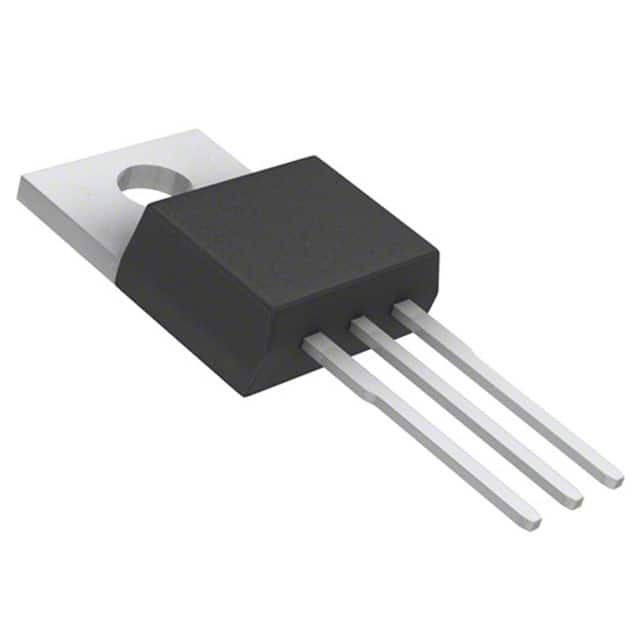Lihat spesifikasi untuk detail produk.

BD242CTU Product Overview
Introduction
The BD242CTU is a versatile semiconductor device that belongs to the category of power transistors. This entry provides an in-depth overview of the BD242CTU, including its basic information, specifications, pin configuration, functional features, advantages and disadvantages, working principles, application field plans, and alternative models.
Basic Information Overview
- Category: Power Transistor
- Use: Amplification and switching of electronic signals
- Characteristics: High voltage and current capability, low saturation voltage
- Package: TO-220AB
- Essence: Silicon NPN transistor
- Packaging/Quantity: Typically available in reels or tubes containing multiple units
Specifications
- Maximum Collector-Emitter Voltage (VCEO): 100V
- Maximum Collector Current (IC): 6A
- Power Dissipation (Pd): 65W
- Transition Frequency (ft): 30MHz
- Operating Temperature Range: -65°C to 150°C
Detailed Pin Configuration
The BD242CTU has a standard TO-220AB package with three pins: 1. Collector (C): Connected to the positive supply voltage 2. Base (B): Controls the transistor's conductivity 3. Emitter (E): Connected to the ground or negative supply voltage
Functional Features
- High voltage capability allows for use in various power applications
- Low saturation voltage minimizes power loss during operation
- Fast switching speed enables efficient signal amplification and switching
Advantages and Disadvantages
Advantages
- High voltage and current handling capacity
- Low saturation voltage reduces power dissipation
- Fast switching speed for efficient signal processing
Disadvantages
- Limited operating temperature range compared to some alternatives
- Relatively lower transition frequency may impact high-frequency applications
Working Principles
The BD242CTU operates based on the principles of bipolar junction transistors (BJTs). When a small current flows into the base terminal, it controls the larger current flowing between the collector and emitter terminals, allowing for signal amplification or switching.
Detailed Application Field Plans
The BD242CTU finds extensive use in various electronic applications, including: - Audio amplifiers - Power supplies - Motor control circuits - Voltage regulators - Switching circuits
Detailed and Complete Alternative Models
Some alternative models to the BD242CTU include: - BD243CTU: Higher collector current rating - BD241CTU: Lower collector current rating - TIP31C: Complementary NPN power transistor - 2N3055: High-power NPN transistor
In conclusion, the BD242CTU is a reliable power transistor with high voltage and current capabilities, making it suitable for a wide range of electronic applications. Its low saturation voltage and fast switching speed further enhance its performance, although users should consider its operating temperature range and transition frequency when selecting it for specific applications.
This comprehensive overview provides valuable insights into the BD242CTU, empowering engineers and enthusiasts to make informed decisions regarding its usage and integration into their electronic designs.
Sebutkan 10 pertanyaan dan jawaban umum terkait penerapan BD242CTU dalam solusi teknis
What is BD242CTU?
- BD242CTU is a silicon NPN power transistor designed for use in general-purpose amplifier and switching applications.
What are the key features of BD242CTU?
- The key features of BD242CTU include a high current capability, low saturation voltage, and high transition frequency.
What are the typical applications of BD242CTU?
- BD242CTU is commonly used in audio amplifiers, power supply circuits, motor control systems, and other general-purpose switching applications.
What is the maximum collector current of BD242CTU?
- The maximum collector current of BD242CTU is 3A.
What is the maximum collector-emitter voltage of BD242CTU?
- The maximum collector-emitter voltage of BD242CTU is 100V.
What is the typical hFE (DC current gain) of BD242CTU?
- The typical hFE of BD242CTU is 30-160 at IC = 0.5A.
What is the power dissipation of BD242CTU?
- The power dissipation of BD242CTU is 65W.
Is BD242CTU suitable for high-frequency applications?
- Yes, BD242CTU has a high transition frequency, making it suitable for high-frequency applications.
Does BD242CTU require a heat sink for operation?
- Yes, BD242CTU may require a heat sink to dissipate heat effectively, especially in high-power applications.
Where can I find the detailed datasheet for BD242CTU?
- The detailed datasheet for BD242CTU can be found on the manufacturer's website or through authorized distributors.

